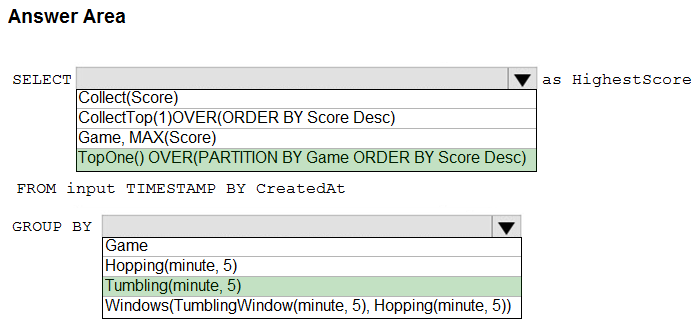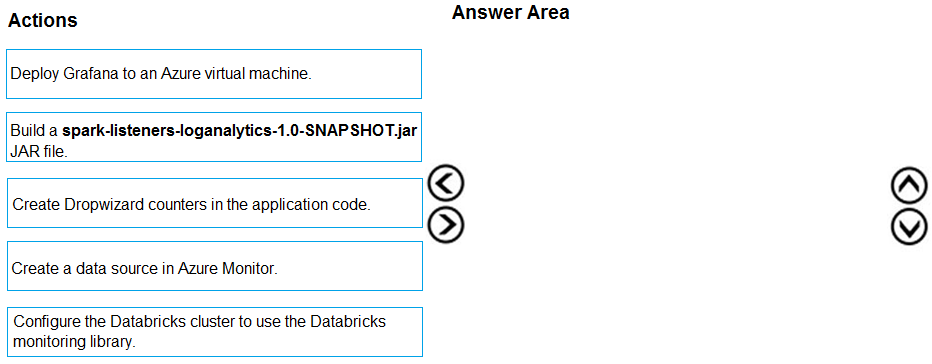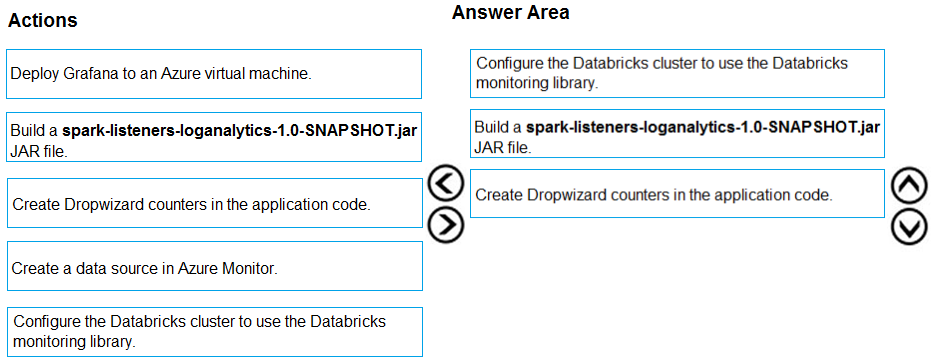You have an Azure SQL database named sqldb1.
You need to minimize the possibility of Query Store transitioning to a read-only state.
What should you do?
Answer:
B
The Max Size (MB) limit isn't strictly enforced. Storage size is checked only when Query Store writes data to disk. This interval is set by the Data Flush Interval
(Minutes) option. If Query Store has breached the maximum size limit between storage size checks, it transitions to read-only mode.
Incorrect Answers:
C: Statistics Collection Interval: Defines the level of granularity for the collected runtime statistic, expressed in minutes. The default is 60 minutes. Consider using a lower value if you require finer granularity or less time to detect and mitigate issues. Keep in mind that the value directly affects the size of Query Store data.
Reference:
https://docs.microsoft.com/en-us/sql/relational-databases/performance/best-practice-with-the-query-store
You have SQL Server 2019 on an Azure virtual machine that runs Windows Server 2019. The virtual machine has 4 vCPUs and 28 GB of memory.
You scale up the virtual machine to 16 vCPUSs and 64 GB of memory.
You need to provide the lowest latency for tempdb.
What is the total number of data files that tempdb should contain?
Answer:
C
The number of files depends on the number of (logical) processors on the machine. As a general rule, if the number of logical processors is less than or equal to eight, use the same number of data files as logical processors. If the number of logical processors is greater than eight, use eight data files and then if contention continues, increase the number of data files by multiples of 4 until the contention is reduced to acceptable levels or make changes to the workload/code.
Reference:
https://docs.microsoft.com/en-us/sql/relational-databases/databases/tempdb-database
HOTSPOT
-
You have an Azure SQL database named DB1 that contains a table named Orders. The Orders table contains a row for each sales order. Each sales order includes the name of the user who placed the order.
You need to implement row-level security (RLS). The solution must ensure that the users can view only their respective sales orders.
What should you include in the solution? To answer, select the appropriate options in the answer area.
NOTE: Each correct selection is worth one point.
Answer:

DRAG DROP
-
You have an Azure subscription that contains an Azure SQL database named SQLDb1. SQLDb1 contains a table named Table1.
You plan to deploy an Azure web app named webapp1 that will export the rows in Table1 that have changed.
You need to ensure that webapp1 can identify the changes to Table1. The solution must meet the following requirements:
• Minimize compute times.
• Minimize storage.
Which three actions should you perform in sequence? To answer, move the appropriate actions from the list of actions to the answer area and arrange them in the correct order.
Answer:

HOTSPOT
-
You have an Azure subscription that is linked to an Azure Active Directory (Azure AD) tenant named contoso.com The subscription contains an Azure SQL database named SQL1 and an Azure web app named app1. App1 has the managed identity feature enabled.
You need to create a new database user for app1.
How should you complete the Transact-SQL statement? To answer select the appropriate options in the answer area.
NOTE: Each correct selection is worth one point.
Answer:

DRAG DROP
-
You have an Azure subscription that contains an Azure SQL database named DB1.
You plan to perform a classification scan of DB1 by using Azure Purview.
You need to ensure that you can register DB1.
Which three actions should you perform in sequence? To answer, move the appropriate actions from the list of actions to the answer area and arrange them in the correct order.
Answer:

You have an Azure virtual machine based on a custom image named VM1.
VM1 hosts an instance of Microsoft SQL Server 2019 Standard.
You need to automate the maintenance of VM1 to meet the following requirements:
✑ Automate the patching of SQL Server and Windows Server.
✑ Automate full database backups and transaction log backups of the databases on VM1.
✑ Minimize administrative effort.
What should you do first?
Answer:
D
Automated Patching depends on the SQL Server infrastructure as a service (IaaS) Agent Extension. The SQL Server IaaS Agent Extension (SqlIaasExtension) runs on Azure virtual machines to automate administration tasks. The SQL Server IaaS extension is installed when you register your SQL Server VM with the SQL
Server VM resource provider.
To utilize the SQL IaaS Agent extension, you must first register your subscription with the Microsoft.SqlVirtualMachine provider, which gives the SQL IaaS extension the ability to create resources within that specific subscription.
Reference:
https://docs.microsoft.com/en-us/azure/azure-sql/virtual-machines/windows/sql-server-iaas-agent-extension-automate-management https://docs.microsoft.com/en-us/azure/azure-sql/virtual-machines/windows/sql-agent-extension-manually-register-single-vm?tabs=bash%2Cazure-cli
HOTSPOT -
You are building an Azure Stream Analytics job to retrieve game data.
You need to ensure that the job returns the highest scoring record for each five-minute time interval of each game.
How should you complete the Stream Analytics query? To answer, select the appropriate options in the answer area.
NOTE: Each correct selection is worth one point.
Hot Area:
Answer:

Box 1: TopOne() OVER(PARTITION BY Game ORDER BY Score Desc)
TopOne returns the top-rank record, where rank defines the ranking position of the event in the window according to the specified ordering. Ordering/ranking is based on event columns and can be specified in ORDER BY clause.
Analytic Function Syntax:
TopOne() OVER ([<PARTITION BY clause>] ORDER BY (<column name> [ASC |DESC])+ <LIMIT DURATION clause> [<WHEN clause>])
Box 2: Tumbling(minute 5)
Tumbling window functions are used to segment a data stream into distinct time segments and perform a function against them, such as the example below. The key differentiators of a Tumbling window are that they repeat, do not overlap, and an event cannot belong to more than one tumbling window.
Reference:
https://docs.microsoft.com/en-us/stream-analytics-query/topone-azure-stream-analytics https://github.com/MicrosoftDocs/azure-docs/blob/master/articles/stream-analytics/stream-analytics-window-functions.md
A company plans to use Apache Spark analytics to analyze intrusion detection data.
You need to recommend a solution to analyze network and system activity data for malicious activities and policy violations. The solution must minimize administrative efforts.
What should you recommend?
Answer:
B
Azure DataBricks does have integration with Azure Monitor. Application logs and metrics from Azure Databricks can be send to a Log Analytics workspace.
Reference:
https://docs.microsoft.com/en-us/azure/architecture/databricks-monitoring/application-logs
DRAG DROP -
Your company analyzes images from security cameras and sends alerts to security teams that respond to unusual activity. The solution uses Azure Databricks.
You need to send Apache Spark level events, Spark Structured Streaming metrics, and application metrics to Azure Monitor.
Which three actions should you perform in sequence? To answer, move the appropriate actions from the list of actions in the answer area and arrange them in the correct order.
Select and Place:
Answer:

Send application metrics using Dropwizard.
Spark uses a configurable metrics system based on the Dropwizard Metrics Library.
To send application metrics from Azure Databricks application code to Azure Monitor, follow these steps:
Step 1: Configure your Azure Databricks cluster to use the Databricksmonitoring library.
Prerequisite: Configure your Azure Databricks cluster to use the monitoring library.
Step 2: Build the spark-listeners-loganalytics-1.0-SNAPSHOT.jar JAR file
Step 3: Create Dropwizard counters in your application code
Create Dropwizard gauges or counters in your application code
Reference:
https://docs.microsoft.com/en-us/azure/architecture/databricks-monitoring/application-logs